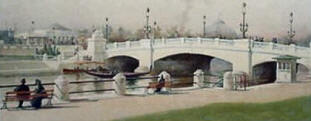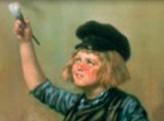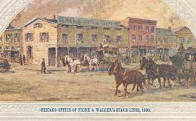Lawrence Carmichael Earle
(1845-1921)
A near contemporary of Frederick S. Church was Lawrence Carmichael
Earle. He was born in New York in 1845, and moved to Grand Rapids as a youth. Like Church,
he studied with Marinus Hartung, but following the
footsteps of Church, he eventually left Grand Rapids to study in Chicago with Walter
Shirlaw. Before moving to Chicago, Earle returned to New York in 1866 and briefly studied
there. Shirlaw recognized Earle's talent and urged him to travel to Europe and enter the
Royal Academy in Munich. It is doubtful that Shirlaw could have greatly influenced Earle
because he did not travel to Europe himself until 1870. At Munich Earle studied with
Ludwig Barth, Franz Wagner, and other distinguished artists of the Academy. Later he
traveled to Italy, where he was impressed with the masters of the Italian Renaissance, but
it was the style and sentiment of the Munich school that left the deepest impression on
the young artist. The thick, painterly use of pigment and heavy impasto characteristic of
the Munich Academy were hallmarks of Earle's later style. In 1881 he returned to New York,
where he took a studio and entered into the city's competitive art scene of the 1880's and
1890's. Earle exhibited intermittently at the National Academy's annual exhibitions from
1888 until after the turn of the century, and in 1897 he was made an associate of the
Academy. Unlike Church, he was never elected a full Academician. Curiously, there is no
record of Earle and F. S. Church resuming their boyhood relationship in New York. Earle
eventually settled in Montclair, New Jersey, after his return to this country from his
studies in Europe. Following the death of his wife in 1909, he returned to Grand Rapids, where he lived until his death in 1921. Earle was a founding member of the Art
Association and influential in its early affairs. He was also a member of the American
Water Color Society, the New York Water Color Club, and the Artists' Fund Society.
In 1911 Earle was honored with an exhibition of his work by
the Grand Rapids Art Association in the St. Cecilia Building. This was the second
exhibition of the newly-organized Association. In 1913 and
again in 1929, after his death, the work of Earle was exhibited at the Art Gallery.
Earle specialized in a popular style of figure, genre, and still-life paintings.
His painting of a Nurse, not dated, gives a flavor of his style of
type characterization. His 1913 exhibition in Grand Rapids received considerable attention in the local press because of his
charming and anecdotal representations of the mountain people of the Appalachia region of
Kentucky. Many of his works were portraits of the character types of the region. Old Man with Geese, not dated, may be a work resulting
from this trip to the mountains of Appalachia. One of Earle's most noted works was called
Life in a Great City (un-located). It was simple in composition and showed two dogs, gaunt
and shivering in a driving storm, standing outside a closed door in the heart of a large
city. The utter dejection of the older dog, whose life has taught it what homelessness and
cold are, and the hopefulness of the younger animal, who still believes in both its
companion and the kindliness of fate, were captured skillfully by the artist.
Unfortunately, other animal paintings by Earle were not so well handled, and on occasion
the artist could be tryingly maudlin. Trout Fishing, not dated,
and the interesting Still Life, are characteristic of his
work.
!Artists of Grand Rapids 1840-1980, J. Gray Sweeney; Grand Rapids, 1981: The
Grand Rapids Art Museum, The Grand Rapids Public Museum



